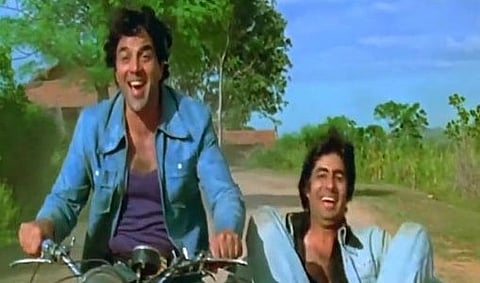
- Home
- Live Blog
- Breaking News
- Top Headlines
- Cities
- NE News
- Sentinel Media
- Sports
- Education
- Jobs

Few stars have carried the weight of an era on their shoulders the way he did
– Neelim Akash Kashyap
(neelimassam@gmail.com)
Some stars do not merely shine; they become a part of the sky we grow up under. Dharmendra was one such presence—an enduring light who shaped the dreams and imaginations of millions. Few stars have carried the weight of an era on their shoulders the way he did. His name alone could fill theatres, lift stories, and stir emotions across generations.
Born Dharam Singh Deol on December 8, 1935, in a quiet Punjabi village, Dharmendra’s journey began far from the spotlight that would later adore him. Raised in a modest Sikh household, he absorbed the values of simplicity, honesty, and hard work—virtues that quietly shaped the man behind the legend. As a young man nurturing a dream that felt too distant to touch, he often imagined himself standing before the camera, inhabiting lives far different from his own. Fate intervened when he won a prestigious talent contest in Bombay, a single moment that altered his destiny and opened the gates of the film world to a determined newcomer.
His cinematic journey began in 1960 with ‘Dil Bhi Tera Hum Bhi Tere’, a film that may not have set the box office roaring but introduced audiences to a face filled with sincerity and an actor with unmistakable promise. The 1960s became the decade of his steady ascent. With ‘Shola Aur Shabnam’, ‘Anpadh’, and ‘Ayee Milan Ki Bela’, he proved his ability to blend gentleness with gravity. But it was ‘Phool Aur Patthar’ that etched his name into the nation’s heart, presenting a raw intensity that marked him as a performer unlike any of his contemporaries.
By the time the 1970s arrived, Dharmendra had transformed from a rising star into a phenomenon. Films like ‘Mera Gaon Mera Desh’ showcased his emotional depth, while ‘Seeta Aur Geeta’ highlighted his effortless comic charm. And then came the cultural earthquake called ‘Sholay’. As Veeru, he carved the most beloved on-screen friendship in Indian cinema, blending humour, vulnerability, and irresistible charisma. The decade overflowed with successes—’Jugnu’, ‘Chupke Chupke’, ‘Dharam Veer’, and ‘The Burning Train’—each reinforcing his range and universal appeal.
The 1980s and 1990s carried him into roles defined by maturity and strength, further proving that he was not an actor bound to a single image. In the years that followed, audiences rediscovered him in films like ‘Life in a… Metro’, ‘Johnny Gaddaar’, and the entire ‘Yamla Pagla Deewana’ series alongside his sons. Even in his later years, when many fade from the screen, Dharmendra continued to glow—his appearances in ‘Rocky Aur Rani Kii Prem Kahaani’ and ‘Teri Baaton Mein Aisa Uljha Jiya’ reminding everyone of the warmth, humour, and honesty he carried effortlessly.
Beyond cinema, Dharmendra’s contributions extended into public life. He served as a Member of Parliament, where his humility and grounded nature earned as much affection as his films ever had. Recognised with the Padma Bhushan for his remarkable contributions to Indian cinema, he remained, above all, a devoted family man—a pillar to a family that continues to shape the story of Indian film.
Across a career of over 300 films, Dharmendra did far more than simply act—he became a symbol of sincere masculinity, of stories rooted in heart and humanity, and of an era when stardom was built on authenticity rather than spectacle. His passing leaves a silence that feels strangely heavy, as if the screen itself has momentarily dimmed. Yet even in this silence, his laughter echoes across generations. His dialogues, gestures, kindness, and unforgettable frames will continue to live in the collective memory of a nation. He may have bid farewell to the world, but the legacy he leaves behind beats with a timeless pulse—eternal, luminous, and deeply loved. And as long as cinema survives, Dharmendra’s spirit will continue to shine in every frame where honesty meets heroism.